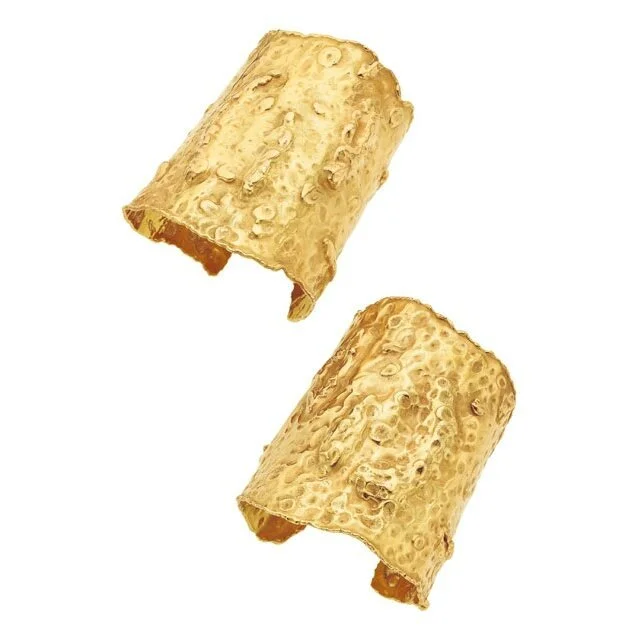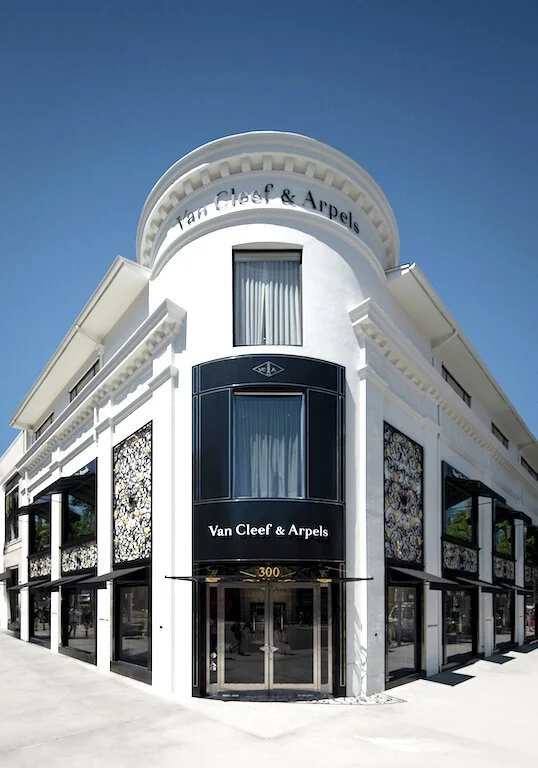Sleep & Dreams
Etruscan cuffs by Van Cleef & Arpels. Photo courtesy of Heritage Auctions.
Once many years ago when I was just starting out, I was killing some time, waiting on a business meeting I had scheduled in Beverly Hills. To those who are not familiar with LA or for whom the name “Beverly Hills” conjures up associations with the real or imagined Lifestyles of the Rich and Famous, this meeting was nothing nearly as glamorous as it, perhaps, sounds. For a young designer like I was at the time, sales meetings like this one were usually more demoralizing than anything else — with retail buyers explaining to you why what you do is “beautiful but not right for our customer,” why your work was “too avant-garde” or “not edgy enough,” why you “should be following this hot new trend” or another that some other hot up-and-coming designer they knew was currently following, or why you should just basically be doing anything else than what you were currently up to. In short, these meetings often were not particularly inspiring.
Nevertheless it was a pleasant, sunny Southern California morning in late Spring, and all the shops were just opening their doors. Although by now I have spent almost 25 years designing jewelry, the staff in some high-end jewelry stores still often makes me uncomfortable from time to time. So, even more so back then, when confronted with a store I really wanted to check out, I often just ended up window shopping. That Spring morning, however, after spending several minutes mesmerized, staring at jewels through the windows at Van Cleef & Arpels, I decided to bite the bullet and go in.
At that hour, as far as I could see, the store was absolutely empty, save for a security guard and a tall, well-dressed man, who I took to be a sales person. He was meticulously turned out but also completely comfortable in his suit and in his skin — catching site of me out of the corner of his eye, as he glided back and forth seamlessly between the perfectly polished showcases.
Photo courtesy of Van Cleef & Arpels.
He left me alone for several minutes to survey their enviable collections on my own. At the same time, he was examining the cases himself, to see if any of the jewelry (which they had probably just spent the last hour or two carefully laying out) was anything less than perfectly displayed. I relished spending these few quiet moments alone, drinking in the detail of so many incredible pieces, before he broke the silence. “You know something about jewelry, don’t you?” he said in a French accent, “I can tell by the way you are looking at the pieces.” He spoke in a pleasant, measured voice which wasn’t at all what I was expecting— not the off-putting opening salvo I had braced myself for. Although we, as Americans, often make fun of the French for being snobbish and aloof, his friendly candor was rather disarming. Unlike most American men, he clearly had a highly developed sense of intuition, and I recognized that his frankness was more a matter of dispensing with triviality than of being confrontational. He seemed to instinctively recognize that, while I was probably not a qualified buyer for his jewelry, I still had a genuine appreciation for what I was seeing, and so there was a basis for a sincere discussion. It was a kind of benevolence that I keenly appreciated at that moment, feeling equal parts intrigued and out of place.
“Yes, I have a little experience designing jewelry,” I explained, and giving him some background about my work, he promptly told me to follow him around the store. Unexpectedly, he glided past all the Alhambra necklaces and the other pieces which most people probably associate with Van Cleef and started pulling out what I would characterize as the good stuff — which is saying something given the level of the “everyday” pieces they had on display.
Over the next 20 or 30 minutes, he pulled jewelry out of cases, out of drawers, out of window displays, and even out of the safe, while explaining to me the story behind each of them or what he felt made each one special or unique. “This bracelet was commissioned for the Duchess of Windsor. It is a cuff fashioned in gold and molded from the shape and texture of her own wrist.” Her wrist was rather wrinkly, I remembered thinking at the time, but still it was a lovely cuff. He showed me extraordinary diamonds, pearls and colored gemstones too. It was a bit overwhelming. Some people say that gemstones hold magical powers, and if they do, I was definitely starting to feel a little bit drunk, seeing so much extraordinary bling in such short order.
Nevertheless, it was clear to me at that moment, that this guy was not some jewelry salesman. Instead, he was someone who had devoted his life and his full attention to what he was doing, and that it wasn’t a matter of how expensive or rare or refined the goods were that he was dealing with. It wasn’t about conspicuously showing off the wealth of pieces he had to offer, or about rubbing elbows with all the successful people he inevitably met during the course of his day. Something else was motivating him. For him, this was a vocation.
As he prepared to slide a particularly chunky diamond lavalier — the center stone had to be at least 30 carats — back into its case, he turned to me and confided, “I have been very sad for the past few weeks.” Concerned by his expression and the sudden change in tone, I asked him what was wrong. He told me that his mentor, a senior member of the Arpels family, had recently passed away in France and that he had not been able to go back to pay his final respects. “He taught me everything I know. He was like my father,” he strained a bit to say, and it was clearly a sore spot for him, that he felt stuck out here among all these Americans while something much more important was happening back home. He continued to relate a few stories about how expert his mentor had been at identifying gemstones and about all the amazing gems he had discovered and made into fabulous pieces of jewelry before most jewelers in the market even understood what they were looking at. His respect for him was deep and palpable.
“He was a good friend of Conrad Hilton, you know?” he explained to me. “He used to tell me that the hotel business and his own business in fine jewelry were very closely aligned.” Asking him to elaborate a little further, he said, “‘When you are doing a business,’” his mentor told him, “‘you must first understand your product. What, essentially, are you asking people to purchase from you? In the hotel business, what you are selling to someone is, fundamentally, a good night’s sleep. You are giving them the experience of comfort, of rest, of a home away from home.’” Nodding in agreement, I asked him, “So what does that have to do with fine jewelry?” At that moment, he kind of straightened himself up a bit, and diverted his gaze from me to some random spot in the distance out the window, clearly beyond all the fashion mavens who were just beginning to take their morning stroll down Rodeo drive. Looking rather wistful and far away, he said “Ahh. In the hotel business you are selling people a good night’s sleep. But with jewelry, you are giving them dreams.”
A little unprepared for the serious turn the conversation had taken, we talked a bit more and exchanged information and pleasantries, before I excused myself to head off to my appointment. This encounter always stayed with me, however, and I have found myself reflecting on it from time to time. Much later, when I was tapped to propose an interior design for Hotel Cerro, I told this story in the context of making my pitch to the owners group. "What does a jewelry designer know about designing a hotel? Well let me tell you… hahaha” It was a bit of a joke at the time, but in retrospect there was something deeper there — something about what he was trying to communicate to me — something I was still trying to wrap my head around.
Now, all these many years later, after achieving my own successes and making my share of mistakes, I wonder if most of what I would characterize as “doing good work” in any field isn’t simply that: giving people dreams. The difficult part with designing, however, is learning the art of knowing what those dreams might be even before they do. Good design or artwork always seems to perfectly absorb the energy of a certain time or place or of a certain group of people — but also to point beyond that moment to something more transcendent. It takes that energy of that moment and distills it into a physical object: an object that resonates with people but that is also true to the artist’s own inner voice and, therefore, to that little kernel of what is universal that dwells within each of us. The object is simply an artifact of that deeper experience.
At it’s essence, maybe all creativity is simply an act of generosity: like that man who took time out to educate and encourage me one sunny Spring morning, or his mentor before him, who had taught him that helping others make their dreams come true was the best path to fulfilling his own.
— Ian Saude, 2021



